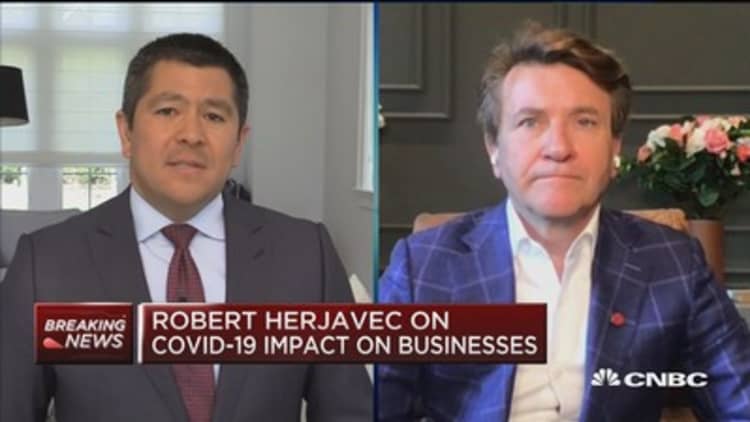We asked experts in various fields for their best predictions on what the world will look like when the coronavirus pandemic finally recedes. In this segment of our series, "The Next Normal," we examine what happens when office life reopens and what becomes of remote work.
***
While President Donald Trump pushes states to allow businesses to reopen, companies in technology, financial services, insurance and other industries that can successfully function over internet lines are choosing to keep their people home.
Long commutes have been replaced with heavy Zoom use, and workers in big cities are in no hurry to sit on crowded subways and buses during rush hour.
Corporate leaders are waiting for some reliable combination of mass testing, therapeutics, contact tracing and possibly even a vaccine, before they'll consider it a worthwhile risk to send employees back into the traditional workplace. Another consideration is child care, and with schools closed across much of the country and summer camps unlikely to proceed as planned, kids are likely to be at home during the day at least for the next few months.
Facebook said last week that most of its employees will be allowed to work from home through the end of 2020. Google parent-company Alphabet plans to open offices for up to 15% of workers as early as June, but the majority of people who can work from home will continue to do so, perhaps through the end of the year.

"We're going to see this come back more slowly than you might have expected," said Liz Fealy, who runs the global workforce advisory group at consulting firm EY. "Especially in organizations where people believe employees can be equally productive at home."
A staggered return
Fealy said that she's hearing companies talk about a variety of different ways to start sending employees back when they believe it's safe.
One general theme is a staggered return, with people coming to the office in waves based on individual risk levels, and increasing in numbers as contact tracing improves.
Another approach could be "clustering employees on teams" so if there's an infection it's easier to identify who is most exposed and needs to be quarantined. Corporations are already looking to employ phone-based contact tracing to help track employees who have been in close proximity at the office, then use that information to inform workers who may have been exposed and ask them to self-quarantine.
Across the 198 global offices of Fidelity National Information Services, a financial technology company, roughly 95% of employees are working from home. Chief Risk Officer Greg Montana doesn't see that lasting forever, but he says there's no returning to the pre-coronavirus days of packed buildings.
From his home setup in Jacksonville, Florida, Montana told CNBC that the first phase of a return to the office will be for those employees who are itching to get back, either because they feel isolated in their current confines and yearn for human contact or because they're struggling to be productive. Even that small initial wave is unlikely to begin until late in the third quarter or early in the fourth, Montana said.
"We are really focused on the health and well-being of our employees," said Montana, who's part of a 40-person crisis management team that's meeting twice a week to work on the company's reentry plan.
Montana said that FIS wants to make sure employees are getting temperature checks, masks are readily available and deep-cleaning processes are in place for meeting rooms. The company is also putting together procedures for travel, so employees can go to a website, type in the desired destination and determine if it's advisable to make the trip.
In the meantime, the company has been issuing virtual private network licenses to employees so they can access the network remotely and offering wireless hotspots to those who lack reliable home Wi-Fi.
"If you're able to be productive at home, we want to get you what you need to be productive," Montana said.
At consumer products giant Newell Brands, parent company of Sharpie, Coleman, Rubbermaid and Crock-Pot, Samantha Charleston is leading the return-to-office task force.
Charleston, a vice president in human resources, told CNBC by email that she's working with local leaders across each of Newell's regions to determine how and when to begin the return process, taking into account government recommendations, office readiness and input from employees gathered through weekly surveys.
Like FIS, Newell is content to take its time, as Covid-19 breakouts continue to emerge in various parts of the U.S.
"For the time being, Newell Brands is continuing our remote work structure for the majority of the office population," Charleston wrote. "The repatriation process back to the office will be slow to make sure we take every safety consideration on behalf of our employees."
Remote tools are exploding
Experts say that even when the coronavirus is in the rearview mirror, many of us will still be working from home.
Now that so many companies have been forced to function with a remote staff and to adopt technologies that enable collaboration from a distance, they've already made the necessary investments, and they know they can save money on office and real estate costs. According to Global Workplace Analytics, employers can save $11,000 a year for every employee who works remotely half the time.
In addition to Zoom, Slack and Microsoft Teams, products like design software Figma and knowledge-sharing tool Guru have seen growth accelerate as companies cobble together a suite of work-from-home products. Alex Konanykhin said his company, TransparentBusiness, which helps customers securely manage remote workforces, has seen an 800% increase in subscriptions since March 1.
Some companies are also paying for remote mental health services and online learning sites for employees. And they've seen positive results.
"In some cases, productivity has accelerated," Charleston said. "A benefit of the new situation is it has given employees an outlet to try new things, think differently, share ideas and find solutions."

Chris Bedi, chief information officer of IT automation software provider ServiceNow, says the terms remote work and work from home are going to disappear.
"There's just work, and it's work from anywhere," said Bedi, in an interview last week.
He said that the talent war will also fundamentally change, because employers will quickly realize that they can start hiring anywhere and attract a whole new set of prospects. And even though there's a level of Zoom fatigue that's setting in from nonstop video calls, the travel market is forever changed, he predicts.
"The concept of getting on a plane for six hours for a two-hour meeting and being jet lagged, people are going to go — why?" Bedi said.
'Zero pressure'
Jeff Snyder, founder of Inspira Marketing Group, said his company approved the purchase of external monitors so the 90 employees with desk jobs could easily get up and running at home. Inspira has an additional 300-plus employees who work in the field doing event-based marketing, a business he says has been "crushed."
Snyder said his human resources team has been actively reconfiguring the offices in Connecticut, New York and Chicago to allow for social distancing and cap the number of people that can be present at a time when they do start coming back. The company has also ordered 10,000 masks.
Despite all the available safety measures, Snyder's not expecting many employees to rush through the door at their first opportunity.
"We know it's not a light switch where all the sudden it's game on," he said. "There's going to be zero pressure forcing people to come back."







